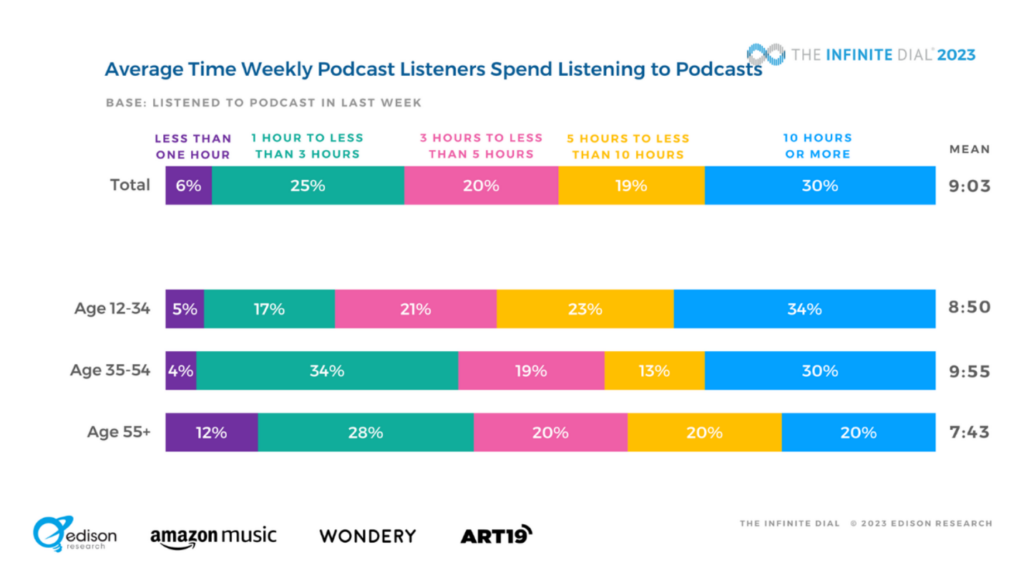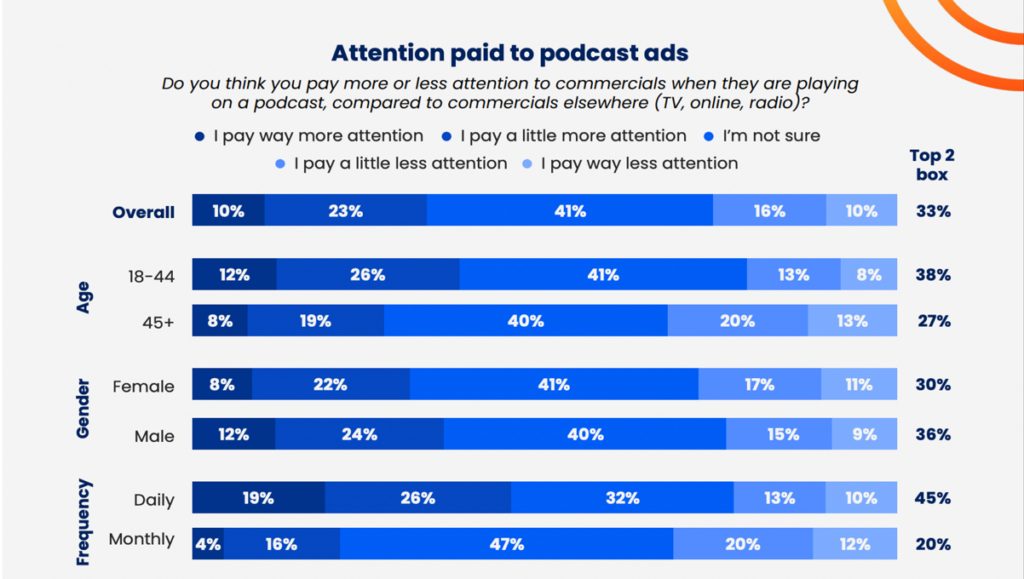Even in the midst of uncertainty, podcasts are providing brand marketers with new opportunities to drive ROI and engage new audiences. In this post, we’ll review some ways marketers can leverage the format to build engagement in creative ways.
Podcast ad revenues are expected to top $2.28 billion in the US in 2023 per Variety, a leap of 25 percent over 2022 spending. There’s good reason for advertisers’ confidence. A recent survey of 1,200 podcast listers showed that 95 percent of American consumers took relevant action after hearing a podcast ad, and 88 percent of Canadian listeners did as well, per MediaPost. Consumers are also listening longer to podcasts this year. According to The Infinite Dial Report by Edison Research in March:
- Fifty-three percent of Americans aged 12-54 have listened to a podcast in the last month.
- Weekly podcast listeners heard an average of nine podcast episodes in the last week, up from eight podcasts in 2022.
- Thirty-eight percent of U.S. adults who have ridden in a car in the last month say they listen to podcasts in the car, up from 32 percent in 2022.
- Weekly podcast listeners hear an average of 9 hours of podcasts per week, with millennials leading all other groups with an average of just under 10 hours per week.

But it isn’t just that consumers are listening to more podcasts for longer periods of time, advertisers are seeing extraordinary ROI, according to a recent report by Acast.
Over 87 percent of podcast advertisers reported that they earned between $4 and $6 for every dollar spent on podcast ads.

Those results could relate to how consumers are listening to podcast ads. A recent survey of 39k podcast listeners by DISQO revealed that 45 percent of daily listeners stated that they paid more attention to podcast ads than those they encountered on other media, per Inside Radio.

In addition, an earlier survey by Acast showed that 95 percent of podcast listeners are more likely to consider a product in a podcast that captures their interest, and 92 percent of listeners said the content of the podcast is important they consider a product. According to the report, 95 percent of American podcast listeners have taken an action as a result of podcast advertising and 97 percent of frequent listeners have researched a product or purchased a product because of a mention heard on a podcast.
How To Start: Develop A CX-Focused Podcast Strategy
Your targeted audience members are potential customers, yes—but they’re listening for the podcast content, not your ad. Think about how your ad might impact their customer experience as “buyers” of the podcast and potential consumers of your product or service.
Ask yourself:
Is our brand right for this audience? Audiences have strong feelings about the podcast content that they choose to consume – for subscribers and faithful weekly listeners, podcasts can be an important part of their social, cultural, or political identity. Be sure that your brand connects with your audience on an authentic level.
Does this network or podcast reflect our brand’s ethos? Consumers tend to respond more favorably to messaging from brands associated with podcasts or podcast hosts that they support. Your ad spend is best spent in an environment where audiences which will be receptive to your brand’s mission.
Is our messaging relevant? As a marketer, you’re used to translating big questions like “Why does it matter?” into compelling creative, but for podcasts, there’s a lot more at risk because of the potentially huge rewards. Leverage research to build an accurate portrait of what matters to the podcast’s audience in practical terms and craft your messaging to connect with those values, preferences, and needs explicitly while respecting the context of the message.
Even if you’ve never thought about podcast advertising, here are some suggestions to consider:
- Think about the consumer as an audience member first: Podcast listeners are often multi-tasking and engaged in an activity that they’d like to be distracted from, like doing chores. Your ads should amplify their enjoyment of the podcast by either leveraging a familiar voice from the podcast or using creative to make the transition to an ad less jarring. For example, popular podcasts like Welcome To Night Vale, Morbid, and No Such Thing As a Fish feature cast members telling personal anecdotes about sponsor products that feel more like a behind-the-scenes aside than a commercial break.
- Deliver value that feels native within the context: Because consumers are actively listening but often engaged in another task, their willingness to tolerate interruptions may be higher, but they might also be more annoyed with ads that feel out of place with the tone and experience of the show and don‘t offer something valuable in return. For many podcasts, the easiest way to do this is to incentivize immediate action with a unique offer that not only delivers valuable metrics on engagement but also provides a reason for audience members to keep the volume up for the next ad in hopes of an intriguing deal.
- Think about long-term brand alliances: When your ad appears on a show or network with a deep fan base or an audience aligned with programming because of cultural or other affinities your brand can tap into that genuine desire to support the brand. A survey by National Public Media, for example, revealed that 61 percent of NPR podcast listeners preferred to buy from brands that sponsored their favorite NPR shows. When appropriate, connect your brand’s mission with the audience’s desire to support their favorite podcast in a tangible way.
- Stay on top of the data: Per the latest research, look for opportunities with smaller podcasts, be flexible with ad frequency, and use podcast advertising at both ends of the funnel.

